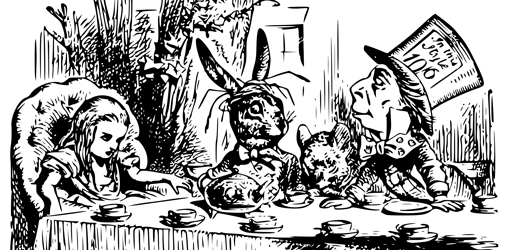A Mad Tea (D) Party
Posted on December 18, 2011 | posted by:“Have you any idea why a raven is like a writing desk?”
I bet you don’t. The Mad Hatter poses this illustrious riddle in the chapter ‘A Mad Tea Party’ in Lewis Carroll’s Alice in Wonderland. The riddle is not meant to have an answer at all: As delightful as it is confusing, it is merely one of the book’s many mysteries that bewilder Alice, and through her, the reader as well.
Every single one of my fellow students would agree that the TransD process is a lot like being Alice stumbling through Wonderland. Right can be wrong, wrong might be right and every question raises further questions rather than answers. To understand and master this process, we have to start with finding out how deep the rabbit hole really is. So let’s dive in.
The TD process must be to an outsider what the Mad Tea Party was to Alice: Commotion, interruption and disorder and a potpourri of disciplines and nationalities running around, asking questions without getting any answers, changing direction and in the middle of this pandemonium a reverberate “CHANGE PLACES!” and everything starts all over. A Transdisciplinary Designer might therefore be perceived to be as ‘mad as a hatter’. This phrase dates back to a time when mercury was used in the process of curing felt for hats. Inhaling the mercury fumes caused severe poisoning, often resulting in neurological damage.
But unlike the Mad Hatter’s party, the TD program is made up of intelligent and rational people. The chaos in our tea party stems from the fact that we do not yet have the ultimate universal answer to what the TD process is. This makes sense, as we are still in the process of creating, shaping and exploring it.
Let’s go back to the tea party scene: Alice sits at a table with the March Hare, the Mad Hatter, and the Dormouse, when the Hatter asks her about his riddle:
“Have you guessed the riddle yet?” the Hatter said, turning to Alice again.
“No, I give it up,” Alice replied. “What’s the answer?”
“I haven’t the slightest idea,” said the Hatter.
“Nor I,” said the March Hare.
Alice sighed wearily. “I think you might do something better with the time,” she said, “than wasting it in asking riddles that have no answers.”
And there it is. A riddle with no answer, the mere concept of which frustrated and confused Alice. Frustration and confusion are familiar emotions to us TD-ers indeed. In fact, much like Alice, we are struggling to find an answer to a similar riddle of our own: What is Transdisciplinary Design? This seemingly unsolvable question is asked all the time: by us, by our professional partners, by teachers and friends… We are faced with a constant demand, internal and external, for a solution to our answerless riddle. Lewis Carroll had to deal with a similar conundrum regarding the riddle of the Mad Hatter. He wrote in the preface to the 1896 edition of his book:
„Enquiries have been so often addressed to me, as to whether any answer to the Hatter’s Riddle can be imagined, that I may as well put on record here what seems to me to be a fairly appropriate answer, viz: ‘Because it can produce a few notes, though they are very flat; and it is never put with the wrong end in front!’ This, however, is merely an afterthought; the Riddle, as originally invented, had no answer at all.“
(Notable here is, that Mr Carroll originally wrote: “… it is NEVAR put with the wrong end in front!”. Got it? However, an ambitious 1896 proofreader changed it, assuming it was just misspelled. What a loss, and again an issue of communication.)
If we can not provide any answers, how can we convince stakeholders to trust us, feel comfortable with and invest in a process of uncertainty, which on its own is hard enough? And in finding an answer (and I say an answer rather the answer, since I believe several answers are possible), what should we define first: the TD process or the way to communicate it? The answer of course is: “Both at the same time“.
Here are several answers that were created for the raven riddle:
Because the notes for which they are noted are not noted for being musical notes. (Sam Loyd)
Because Poe wrote on both. (also Sam Loyd)
Because there is a B in both and an N in neither. (Aldous Huxley)
Though these responses are not perfect, they are inventive and cover part of the wide scope of potential answers the riddle created. As George E. P. Box says: “Essentially, all models are wrong, but some are useful.“
Maybe we are lost because we are trying to find one right answer to our riddle. Perhaps our riddle can only be solved through a combination of valid and useful answers and TD models, each appropriate for a specific audience. This will allow us to flexibly describe the fluctuating process of Transdisciplinary Design without constraining it to a fixed definition.
Finally, I’ll give it a go with the raven riddle myself:
Why is a raven like a writing desk?
– Because my spoon is too big!
